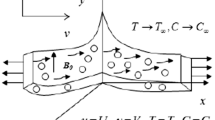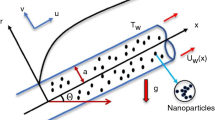Abstract
The sensitivity analysis of the magnetohydrodynamic thermal Marangoni convection of ethylene glycol (EG)-based titania (TiO2) nanoliquid is carried out by considering the effect of nanoparticle aggregation. The rate of heat transfer is explored by utilizing response surface methodology and estimating the sensitivity of the heat transfer rate toward the effective parameters: radiation parameter (1 ≤ R ≤ 3), magnetic parameter (1 ≤ M ≤ 3) and nanoparticle volume fraction \((1\% \le \phi \le 5\%\)). The heat transfer phenomenon is scrutinized with thermal radiation and variable temperature at the surface. The effective thermal conductivity and viscosity with aggregation are modeled by using the Maxwell–Bruggeman and Krieger–Dougherty models. The governing equations are solved by using the apposite similarity transformations. It is found that when the effect of aggregation is considered, the velocity profile is lower. A positive sensitivity of the Nusselt number toward thermal radiation is observed. Further, a negative sensitivity of the heat transfer rate is observed toward the magnetic field and nanoparticle volume fraction.









Similar content being viewed by others
Abbreviations
- u, v :
-
Fluid velocity in x and y directions (m s−1)
- T :
-
Temperature (K)
- \(T_{\infty }\) :
-
Ambient temperature (K)
- k :
-
Thermal conductivity (W m−1 K−1)
- c p :
-
Effective specific heat coefficient of fluid (J kg−1 K−1)
- B :
-
Variable magnetic field
- B 0 :
-
Uniform magnetic field (T)
- A :
-
Positive dimensional constant
- k R :
-
Rosseland mean absorption coefficient (m−1)
- q r :
-
Radiative heat flux (W m−2)
- n :
-
Exponent of temperature variation
- Nux :
-
Reduced Nusselt number
- f :
-
Dimensionless stream function
- \(L,\zeta_{1} , \zeta_{2}\) :
-
Constants
- k a :
-
Thermal conductivity of the aggregates (W m−1 K−1)
- D :
-
Fractal index
- r a, r p :
-
Radii of aggregates and nanoparticles (m)
- R :
-
Thermal radiation parameter
- M :
-
Magnetic parameter
- Prf :
-
Prandtl number
- \(\rho\) :
-
Density (kg m−3)
- \(\mu\) :
-
Dynamic viscosity (kg m−1 s−1)
- \(\nu\) :
-
Kinematic viscosity (m2 s−1)
- \(\sigma_{\text{e}}\) :
-
Electrical conductivity (S m−1)
- \(\alpha\) :
-
Thermal diffusivity (m2 s−1)
- \(\phi\) :
-
Nanoparticle volume fraction
- \(\sigma\) :
-
Surface tension (N m−1)
- \(\sigma_{0}\) :
-
Surface tension at the temperature \(T_{\infty }\) (N m−1)
- \(\sigma_{\text{sb}}\) :
-
Stefan–Boltzmann constant
- \(\theta\) :
-
Dimensionless temperature
- \(\psi\) :
-
Stream function
- \(\eta\) :
-
Similarity variable
- \(\beta_{\text{i}}\) :
-
Regression coefficients
- \(\phi_{\text{m}}\) :
-
Maximum volume fraction of nanoparticles
- \(\phi_{\text{a}}\) :
-
Volume fraction of nanoparticle aggregates
- \(\left[ \eta \right]\) :
-
Einstein coefficient
- f:
-
Base fluid
- nf:
-
Nanoliquid
- S:
-
Nanoparticle
References
Choi SUS, Eastman JA. Enhancing thermal conductivity of fluids with nanoparticles. J Chem Eng Data. 1995;8(3):281–5.
Chen H, Ding Y, He Y, Tan C. Rheological behaviour of ethylene glycol based titania nanofluids. Chem Phys Lett. 2007. https://doi.org/10.1016/j.cplett.2007.07.046.
Shah Z, Ullah A, Bonyah E, Ayaz M, Islam S, Khan I. Hall effect on titania nanofluids thin film flow and radiative thermal behavior with different base fluids on an inclined rotating surface. AIP Adv. 2019. https://doi.org/10.1063/1.5099435.
Mebarek-Oudina F. Convective heat transfer of titania nanofluids of different base fluids in cylindrical annulus with discrete heat source. Heat Transf Asian Res. 2019. https://doi.org/10.1002/htj.21375.
Hosseinzadeh K, Afsharpanah F, Zamani S, Gholinia M, Ganji DD. A numerical investigation on ethylene glycol–titanium dioxide nanofluid convective flow over a stretching sheet in presence of heat generation/absorption. Case Stud Therm Eng. 2018. https://doi.org/10.1016/j.csite.2018.04.008.
Siddiqui AA, Sheikholeslami M. TiO2–water nanofluid in a porous channel under the effects of an inclined magnetic field and variable thermal conductivity. Appl Math Mech. 2018. https://doi.org/10.1007/s10483-018-2359-6.
Danish M, Yahya SM, Saha BB. Modelling and optimization of thermophysical properties of aqueous titania nanofluid using response surface methodology. J Therm Anal Calorim. 2019. https://doi.org/10.1007/s10973-019-08673-z.
Ghadikolaei SS, Hosseinzadeh K, Ganji DD. Investigation on ethylene glycol–water mixture fluid suspend by hybrid nanoparticles (TiO2–CuO) over rotating cone with considering nanoparticles shape factor. J Mol. 2018. https://doi.org/10.1016/j.molliq.2018.09.084.
Ganesh NV, Vishnu Ganesh N, Al-Mdallal QM, Al Fahel S, Dadoa S. Riga—plate flow of γ Al2O3-water/ethylene glycol with effective Prandtl number impacts. Heliyon. 2019. https://doi.org/10.1016/j.heliyon.2019.e01651.
Wang B-X, Zhou L-P, Peng X-F. A fractal model for predicting the effective thermal conductivity of liquid with suspension of nanoparticles. Int J Heat Mass Transf. 2003. https://doi.org/10.1016/s0017-9310(03)00016-4.
Halelfadl S, Estellé P, Aladag B, Doner N, Maré T. Viscosity of carbon nanotubes water-based nanofluids: influence of concentration and temperature. Int J Therm Sci. 2013. https://doi.org/10.1016/j.ijthermalsci.2013.04.013.
Heris SZ, Zeinali Heris S, Razbani MA, Estellé P, Mahian O. Rheological behavior of zinc-oxide nanolubricants. J Disper Sci Technol. 2015. https://doi.org/10.1080/01932691.2014.945595.
Wolthers W, Duits MHG, van den Ende D, Mellema J. Shear history dependence of the viscosity of aggregated colloidal dispersions. J Rheol. 1996. https://doi.org/10.1122/1.550783.
Benos LT, Th. Benos L, Karvelas EG, Sarris IE. Crucial effect of aggregations in CNT-water nanofluid magnetohydrodynamic natural convection. Therm Sci Eng Prog. 2019. https://doi.org/10.1016/j.tsep.2019.04.007.
Ellahi R, Hassan M, Zeeshan A. Aggregation effects on water base Al2O3-nanofluid over permeable wedge in mixed convection. Asia-Pac J Chem Eng. 2016. https://doi.org/10.1002/apj.1954.
Kolsi L, Oztop H, Ghachem K, Almeshaal M, Mohammed H, Babazadeh H, et al. Numerical study of periodic magnetic field effect on 3D natural convection of MWCNT-water/nanofluid with consideration of aggregation. Processes. 2019. https://doi.org/10.3390/pr7120957.
Napolitano LG, Golia C. Coupled marangoni boundary layers. Acta Astronaut. 1981. https://doi.org/10.1016/0094-5765(81)90096-5.
Golia C, Viviani A. Non isobaric boundary layers related to Marangoni flows. Meccanica. 1986. https://doi.org/10.1007/bf01556486.
Chamkha AJ, Pop I, Takhar HS. Marangoni mixed convection boundary layer flow. Meccanica. 2006. https://doi.org/10.1007/s11012-005-3352-y.
Lin Y, Li B, Zheng L, Chen G. Particle shape and radiation effects on Marangoni boundary layer flow and heat transfer of copper-water nanofluid driven by an exponential temperature. Powder Technol. 2016. https://doi.org/10.1016/j.powtec.2016.06.029.
Sheikholeslami M, Ganji DD. Influence of magnetic field on CuO–H2O nanofluid flow considering Marangoni boundary layer. Int J Hydrog Energy. 2017. https://doi.org/10.1016/j.ijhydene.2016.09.121.
Ellahi R, Zeeshan A, Hassan M. Particle shape effects on Marangoni convection boundary layer flow of a nanofluid. Int J Numer Method Heat. 2016. https://doi.org/10.1108/hff-11-2014-0348.
Mahanthesh B, Gireesha BJ, PrasannaKumara BC, Shashikumar NS. Marangoni convection radiative flow of dusty nanoliquid with exponential space dependent heat source. Nucl Eng Technol. 2017. https://doi.org/10.1016/j.net.2017.08.015.
Aly EH, Ebaid A. Exact analysis for the effect of heat transfer on MHD and radiation Marangoni boundary layer nanofluid flow past a surface embedded in a porous medium. J Mol. 2016. https://doi.org/10.1016/j.molliq.2015.12.108.
Ganesh NV, Vishnu Ganesh N, Kameswaran PK, Al-Mdallal QM, Abdul Hakeem AK, Ganga B. Non-linear thermal radiative Marangoni boundary layer flow of gamma Al2O3 nanofluids past a stretching sheet. J Nanofluids. 2018. https://doi.org/10.1166/jon.2018.1510.
Sheremet MA, Pop I. Marangoni natural convection in a cubical cavity filled with a nanofluid. J Therm Anal Calorim. 2019. https://doi.org/10.1007/s10973-018-7069-2.
Ganesh NV, Vishnu Ganesh N, Chamkha AJ, Al-Mdallal QM, Kameswaran PK. Magneto-Marangoni nano-boundary layer flow of water and ethylene glycol based γ Al2O3 nanofluids with non-linear thermal radiation effects. Case Stud Therm Eng. 2018. https://doi.org/10.1016/j.csite.2018.04.019.
Darbari B, Rashidi S, Esfahani JA. Sensitivity analysis of entropy generation in nanofluid flow inside a channel by response surface methodology. Entropy. 2016. https://doi.org/10.3390/e18020052.
Mackolil J, Mahanthesh B. Sensitivity analysis of radiative heat transfer in Casson and nano fluids under diffusion-thermo and heat absorption effects. Eur Phys J Plus. 2019. https://doi.org/10.1140/epjp/i2019-12949-6.
Pordanjani AH, Vahedi SM, Rikhtegar F, Wongwises S. Optimization and sensitivity analysis of magneto-hydrodynamic natural convection nanofluid flow inside a square enclosure using response surface methodology. J Therm Anal Calorim. 2019. https://doi.org/10.1007/s10973-018-7652-6.
Vahedi SM, Pordanjani AH, Raisi A, Chamkha AJ. Sensitivity analysis and optimization of MHD forced convection of a Cu-water nanofluid flow past a wedge. Eur Phys J Plus. 2019. https://doi.org/10.1140/epjp/i2019-12537-x.
Shirvan KM, Mamourian M, Mirzakhanlari S, Ellahi R. Numerical investigation of heat exchanger effectiveness in a double pipe heat exchanger filled with nanofluid: a sensitivity analysis by response surface methodology. Powder Technol. 2017. https://doi.org/10.1016/j.powtec.2017.02.065.
Hayat T, Ijaz Khan M, Farooq M, Alsaedi A, Yasmeen T. Impact of Marangoni convection in the flow of carbon-water nanofluid with thermal radiation. Int J Heat Mass Transf. 2017. https://doi.org/10.1016/j.ijheatmasstransfer.2016.08.115.
Ellahi R, Hassan M, Zeeshan A. Shape effects of nanosize particles in Cu–H2O nanofluid on entropy generation. Int J Heat Mass Transf. 2015. https://doi.org/10.1016/j.ijheatmasstransfer.2014.10.041.
Kierzenka J, Shampine LF. A BVP solver based on residual control and the Maltab PSE. ACM Trans Math Softw. 2001. https://doi.org/10.1145/502800.502801.
Arifin NM, Nazar R, Pop I. Non-isobaric Marangoni boundary layer flow for Cu, Al2O3 and TiO2 nanoparticles in a water based fluid. Meccanica. 2011. https://doi.org/10.1007/s11012-010-9344-6.
Acknowledgements
The authors are grateful to the management of CHRIST (Deemed to be University), Bengaluru, India, for their constant support to accomplish this research work. We also thank the Editor and the anonymous reviewers for their constructive suggestions to improve the quality of this article.
Author information
Authors and Affiliations
Corresponding author
Ethics declarations
Conflict of interest
The authors report no conflict of interest in this paper.
Additional information
Publisher's Note
Springer Nature remains neutral with regard to jurisdictional claims in published maps and institutional affiliations.
Rights and permissions
About this article
Cite this article
Mackolil, J., Mahanthesh, B. Sensitivity analysis of Marangoni convection in TiO2–EG nanoliquid with nanoparticle aggregation and temperature-dependent surface tension. J Therm Anal Calorim 143, 2085–2098 (2021). https://doi.org/10.1007/s10973-020-09642-7
Received:
Accepted:
Published:
Issue Date:
DOI: https://doi.org/10.1007/s10973-020-09642-7




